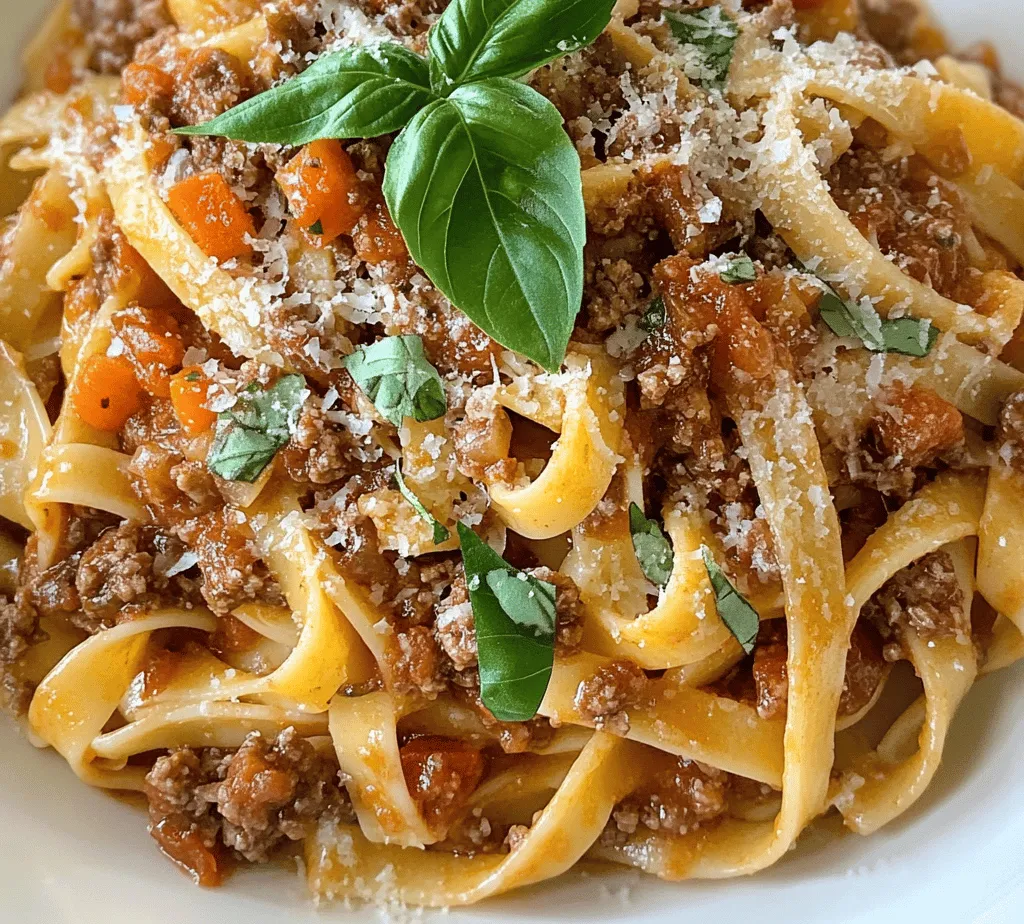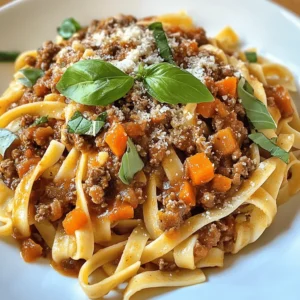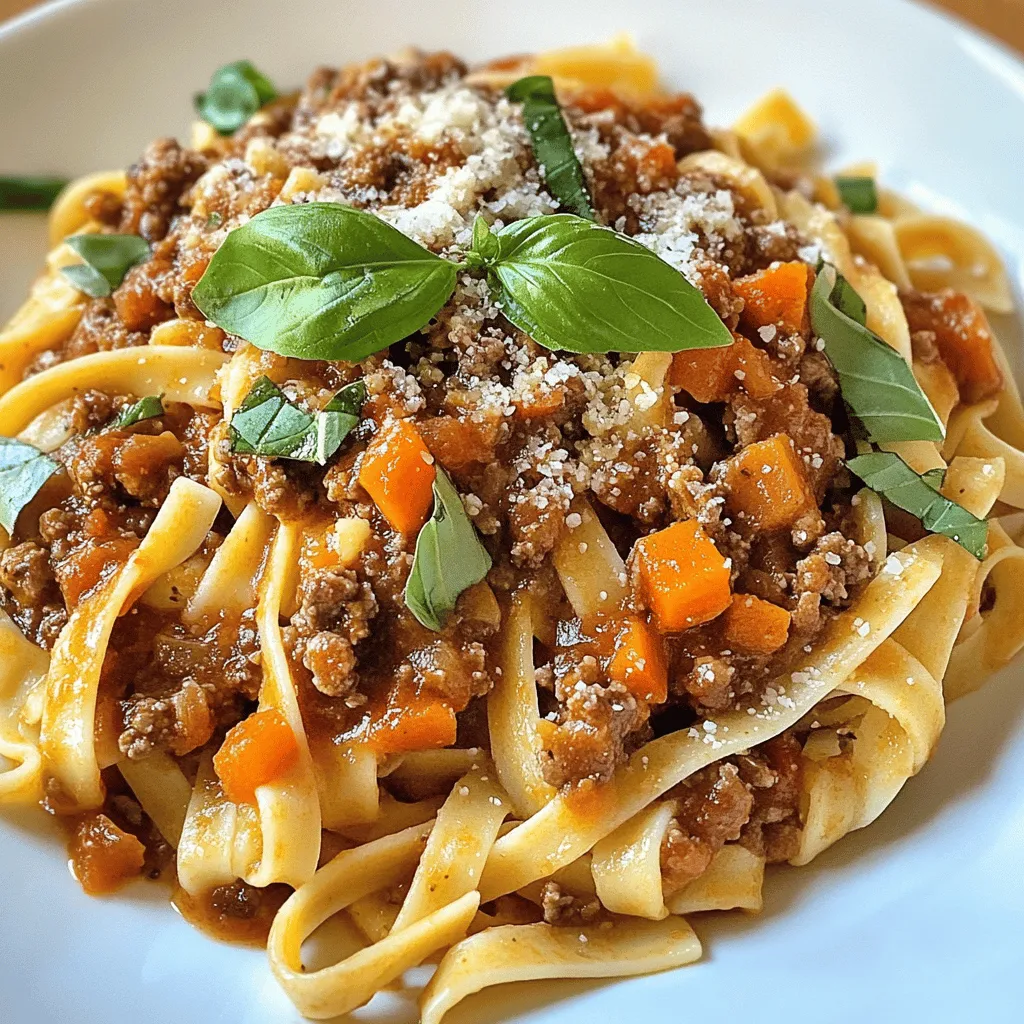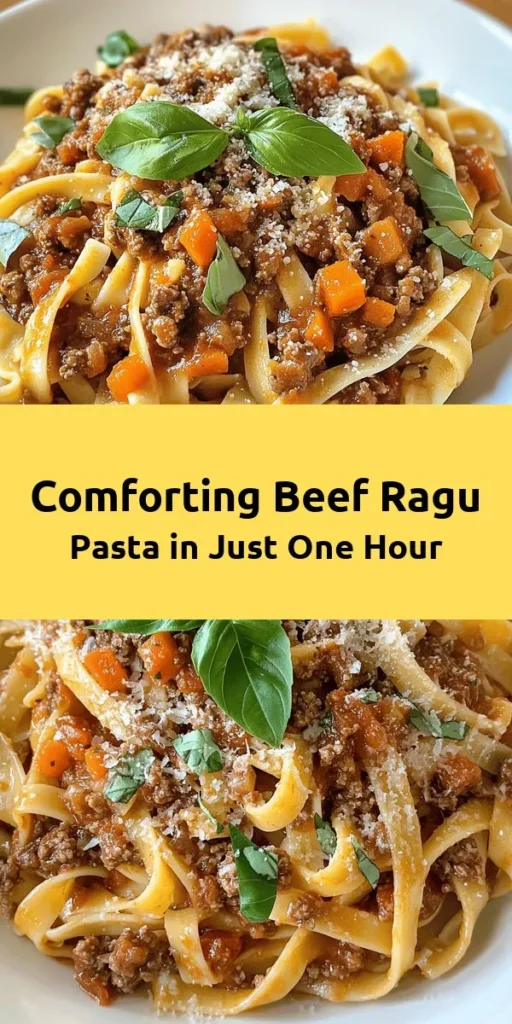Introduction
Hearty Beef Ragu Pasta is more than just a meal; it’s a comforting embrace on a plate. Originating from the rich culinary traditions of Italy, this dish captures the essence of slow cooking and deep, savory flavors. With its tender ground beef simmered in a luscious tomato sauce, served over a bed of perfectly cooked pasta, Beef Ragu is a staple that brings families together. Whether it’s a cozy weeknight dinner or a gathering with friends, this dish offers warmth and satisfaction that few can rival.
One of the key aspects that makes homemade Beef Ragu Pasta so special is the sauce. Unlike store-bought alternatives, a homemade ragu allows for a depth of flavor that comes only from fresh, quality ingredients simmered together over time. The rich, aromatic notes of herbs and spices meld with the sweetness of tomatoes, creating a symphony of flavors that elevate the dish to new heights. Crafting your own pasta sauce not only enhances the taste but also fills your kitchen with an irresistible aroma that beckons everyone to the dinner table.
This dish’s appeal lies in the balance of its carefully selected ingredients. Each component plays its part in crafting a robust flavor profile. From the type of pasta you choose to the quality of ground beef and the medley of vegetables, every decision contributes to the ultimate dining experience. In this article, we’ll explore the ingredients that make Hearty Beef Ragu Pasta so delicious and provide step-by-step instructions to guide you in creating this Italian masterpiece at home.
Understanding the Ingredients
To create the perfect Hearty Beef Ragu Pasta, it’s essential to understand the role each ingredient plays in the overall flavor and texture of the dish. Let’s delve into the main components that will transform your simple pasta into a culinary delight.
Pasta: Choosing the Right Type
When it comes to pasta for Beef Ragu, the choice between fettuccine and pappardelle can significantly impact the dish’s texture. Fettuccine, with its flat and wide shape, is excellent for holding onto the ragu sauce, ensuring every bite is flavorful. On the other hand, pappardelle, which is even wider and has a slightly thicker texture, offers a heartier mouthfeel that pairs beautifully with rich sauces. Both options are great; it ultimately comes down to personal preference. For a traditional touch, pappardelle is often favored in Italian ragu recipes.
Ground Beef: Importance of Quality Meat for Flavor
The quality of ground beef you choose is crucial to the overall taste of your ragu. Opt for ground beef that has a higher fat content, ideally around 80/20. This ratio ensures that the meat remains juicy and flavorful during the cooking process. Additionally, sourcing grass-fed or organic beef can enhance the taste, providing a richer flavor profile. Keep in mind that the beef will be the star of your dish, so investing in quality meat will pay off in the final result.
Vegetables: Building a Flavorful Base
In a classic ragu, the holy trinity of vegetables—onion, carrot, and celery—forms the aromatic base that enhances the dish’s complexity.
– Onion provides sweetness and depth. Yellow onions are typically used for their balanced flavor.
– Carrot adds a natural sweetness that balances the acidity of the tomatoes.
– Celery contributes a subtle earthiness and crunch.
Chopping these vegetables finely and sautéing them until they are soft not only maximizes their flavors but also ensures they meld seamlessly into the sauce.
Tomatoes: Fresh vs. Canned
The choice between fresh and canned tomatoes can significantly impact the sauce’s flavor. While fresh tomatoes can be delicious, they often lack the concentrated sweetness required for a robust ragu. Canned tomatoes, especially San Marzano varieties, are usually picked at peak ripeness and offer a depth of flavor that is hard to replicate with fresh. Look for whole or crushed canned tomatoes with no added preservatives for the best results. If you prefer a fresher taste, you can mix fresh tomatoes into the sauce, but be mindful of the balance between acidity and sweetness.
Herbs and Spices: Enhancing Flavor
To elevate your ragu, a selection of herbs and spices is essential. Oregano and basil are traditional Italian herbs that lend aromatic hints to the sauce. Dried versions work well, but fresh herbs can take the flavor to another level. A pinch of red pepper flakes can also add a subtle heat, balancing the richness of the beef and tomatoes.
Feel free to experiment with other herbs like thyme or rosemary for a unique twist. Remember, the key is to enhance rather than overpower the natural flavors of the dish.
Optional Ingredients: Customizing the Dish
One of the great things about Beef Ragu is its versatility. You can customize the recipe to suit your taste. For instance, adding a splash of red wine during the cooking process deepens the flavor and adds a sophisticated touch. If you enjoy a creamier sauce, consider stirring in a bit of heavy cream or mascarpone cheese just before serving. Additionally, incorporating mushrooms or bell peppers can introduce new textures and flavors to the dish.
Preparation Steps Explained
Proper preparation is crucial for an enjoyable cooking experience and a successful dish. Let’s walk through the essential steps to ensure your Hearty Beef Ragu Pasta turns out perfectly.
Importance of Ingredient Prep
Before diving into the cooking process, take the time to prep your ingredients. Chop the onions, carrots, and celery into small, uniform pieces. This uniformity will ensure even cooking and flavor distribution throughout the sauce. Having all your ingredients at hand will streamline the process and prevent any last-minute scrambling in the kitchen.
Cooking Pasta: Achieving the Perfect Al Dente Texture
While your ragu is simmering, it’s the perfect time to cook your pasta. Fill a large pot with water, adding a generous amount of salt once it reaches a boil. The water should taste like the sea, as this is your opportunity to season the pasta itself. For the best results, follow the package instructions to achieve al dente texture, which means the pasta should be firm to the bite. This slight resistance will enhance the overall eating experience and prevent the pasta from becoming mushy once combined with the ragu.
Sautéing Vegetables: Techniques for Maximizing Flavor
Heat a large, heavy-bottomed pot or Dutch oven over medium heat. Add a drizzle of olive oil and allow it to warm. Then, add your finely chopped onions, carrots, and celery. Sauté the mixture until the vegetables are soft and fragrant, about 5-7 minutes. This step is vital, as it forms the aromatic base that will infuse your ragu with flavor. Stir occasionally to prevent any sticking or burning.
Browning Beef: The Significance of This Step
Once the vegetables are softened, it’s time to add the ground beef. Ensure the meat is at room temperature before adding it to the pot for optimal browning. Increase the heat to medium-high and break the beef apart with a wooden spoon while it cooks. Allow the meat to brown evenly without stirring too frequently; this caramelization process will develop a rich, deep flavor. Once the beef is fully cooked and browned, drain any excess fat if necessary, but keep a bit to contribute to the sauce’s richness.
Adding Tomatoes: Balancing Acidity and Sweetness
With the beef browned and ready, it’s time to add the tomatoes. If using whole canned tomatoes, crush them by hand or with a spoon before adding them to the pot. Stir everything together and bring the mixture to a gentle simmer. At this stage, it’s essential to taste the sauce and assess the balance of flavors. If the sauce is too acidic, consider adding a pinch of sugar to enhance the sweetness.
Seasoning: Elevating the Dish
Seasoning is a crucial element in cooking and should be done throughout the preparation process. After adding the tomatoes, sprinkle in your chosen herbs, and adjust the seasoning with salt and pepper. Remember that you can always add more, but it’s best to start with a little and build up to your desired flavor profile.
With these initial steps complete, your Hearty Beef Ragu Pasta is well on its way to becoming a delicious dish that will warm your soul and satisfy your cravings. In the next part of the article, we will delve into the cooking of the ragu sauce, detailing the simmering process and how to perfectly combine it with your pasta for a delightful meal. Stay tuned for the continuation of this mouthwatering journey!

Step-by-Step Guide to Simmering the Sauce
To create a robust and flavorful Hearty Beef Ragu, the simmering process is crucial. Once you have sautéed your aromatic vegetables and browned the beef, it’s time to introduce the liquids and let the magic happen.
1. Combine Ingredients: After browning the meat, stir in the tomato paste, allowing it to caramelize slightly for deeper flavor. Then, pour in your crushed tomatoes, red wine, and beef stock. Mix thoroughly.
2. Bring to a Boil: Increase the heat to medium-high until the mixture reaches a gentle boil. This step is essential for integrating the flavors right from the start.
3. Reduce Heat and Simmer: Once boiling, reduce the heat to low. Cover the pot partially to allow some steam to escape while still keeping moisture in the sauce. This method helps concentrate flavors without drying out the meat. Aim for a simmering time of at least 1.5 to 2 hours, stirring occasionally. The longer you simmer, the more complex the flavors will become.
Importance of Simmering Time for Flavor Development
The simmering time plays a significant role in developing the flavor profile of your Hearty Beef Ragu. As the sauce cooks, the beef becomes tender, and the flavors meld beautifully. The slow cooking process allows the ingredients to break down and release their natural oils and juices, creating a rich and hearty sauce. Each hour adds layers of flavor, transforming simple ingredients into a luxurious meal.
Tips for Adjusting Consistency with Reserved Pasta Water
As your sauce simmers, you may find that it becomes too thick. This is where the reserved pasta water comes in handy. When cooking your pasta, save about a cup of the starchy cooking water before draining.
– Adjusting Thickness: If your ragu is too thick, gradually add small amounts of reserved pasta water to reach your desired consistency. The starch in the pasta water helps bind the sauce to the pasta, enhancing the overall dish.
– Achieving Creaminess: For a creamier texture, add a splash of heavy cream or a knob of butter along with the pasta water. This will elevate the richness of your dish and give it a velvety finish.
Flavor Integration: Discussing How Flavors Meld During Cooking
As your Hearty Beef Ragu simmers, the integration of flavors occurs through a complex process of cooking. The beef releases its juices, which intermingle with the acidity from the tomatoes and the depth of the red wine. Aromatic herbs like bay leaves and thyme infuse their essence into the sauce. Each ingredient enhances the others, creating a harmonious blend that is both comforting and satisfying.
Combining Pasta and Sauce
Once your pasta is cooked al dente, it’s time to combine it with your beautifully simmered ragu. Properly tossing the pasta in the sauce is key to ensuring every bite is flavorful and satisfying.
1. Technique for Tossing: Use a large pot or a deep skillet to combine the pasta and sauce. Add the drained pasta directly into the sauce over low heat. Using tongs or a pasta fork, gently toss the pasta in the sauce to coat it evenly. This technique prevents the pasta from sticking and ensures that every strand is enveloped in the rich ragu.
2. Texture and Sauce Adherence: The right amount of sauce is essential for optimal texture. You want the pasta to be well-coated without being swimming in sauce. The ideal balance allows the sauce to cling to the pasta, enhancing each bite’s flavor while maintaining a pleasant texture.
Serving Suggestions
Presentation can elevate your Hearty Beef Ragu Pasta from a simple meal to an impressive dish. Here are some tips for serving it beautifully:
– Plating: Use a large, shallow bowl for a family-style presentation or individual plates for a more refined look. Twirl the pasta into a nest shape using tongs for a visually appealing centerpiece.
– Garnishing: Fresh basil leaves add a pop of color and a burst of freshness, balancing the richness of the ragu. Grate fresh Parmesan cheese on top for an additional layer of flavor. Not only does it add richness, but it also enhances the dish’s aroma.
– Pairing Ideas: This hearty dish pairs wonderfully with a side of garlic bread or a fresh green salad to lighten the meal. For wine, consider a medium-bodied red, like Chianti or a Cabernet Sauvignon, which complements the flavors of the beef and tomatoes beautifully.
Nutritional Benefits of Hearty Beef Ragu Pasta
Hearty Beef Ragu Pasta is not only delicious but also nutritious. Here’s a look at the nutritional value of this dish:
– Protein Power: The beef in the ragu provides a substantial amount of protein, essential for muscle repair and growth. A serving can contain around 20-25 grams of protein, making it a satisfying choice for dinner.
– Vitamins and Minerals: Tomatoes are rich in vitamins C and K, and they also provide potassium and folate. The addition of vegetables like onions and carrots boosts the dish’s vitamin content.
– Balanced Meal: The combination of carbohydrates from the pasta and the protein from the beef creates a well-rounded meal. This balance is particularly important for maintaining energy levels and feeling full, making it perfect for family dinners.
Cultural Context of Ragu
Ragu sauces have a rich history in Italian cuisine, originating from various regions, each offering unique variations.
– Historical Background: Ragu dates back to the 18th century in Italy, where it was originally made with game meat. Over time, it evolved into the hearty beef ragu we know today, often featuring slow-cooked meats, tomatoes, and a variety of herbs.
– Regional Variations: In Bologna, for instance, the ragu is made with a mix of beef and pork, while in Naples, you might find a ragu with a more pronounced tomato base. Each region has adapted the sauce to reflect local ingredients and culinary traditions, showcasing the versatility of this beloved dish.
Conclusion
Hearty Beef Ragu Pasta is the epitome of comfort food, providing warmth and satisfaction with every bite. The slow-cooked sauce, rich with flavor and tender meat, creates a dish that is both nourishing and indulgent. As you explore homemade sauces, you’ll discover that the depth of flavor achieved through slow simmering is unmatched by store-bought alternatives.
This dish not only nourishes the body but also nourishes the soul, making it an ideal choice for gatherings with family and friends. The joy of sharing a bowl of hearty ragu pasta is an experience that transcends generations, bringing people together around the table. So gather your loved ones, serve this delightful meal, and continue the tradition of enjoying home-cooked comfort food.



